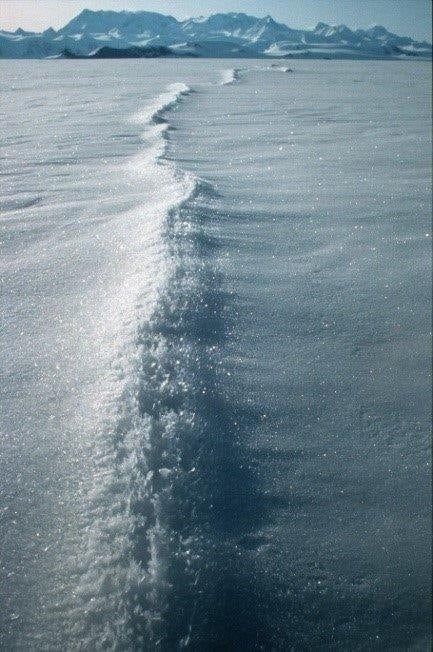
Photograph of surficial strand cracks at the Rutford Glacier at its grounding line. See National copy NNICE: Antarctica is shrinking because the sea floor is being eroded - by warm water. Global warming is causing vast swathes of the land underneath the frozen continent to be carried away - leading to structural instability in the great ice sheet. Now entire cliffs of ice that have stood for millions of years are breaking off and falling into the ocean, because the land they were built on has been subject to rapid erosion.
A huge earthquake in the tropics could trigger another Ice Age, warns new research.
Earth turns into a snowball when tectonic plates smash into each other beneath the ocean, say scientists.
The mega collisions set off chain reactions that sends global temperatures plummeting.
Over the last 540 million years the Earth has weathered three such events – with ice sheets and glaciers stretching far beyond the polar caps.
And they start around the equator – including the Pacific Ring of Fire which houses more than 450 volcanoes, making it the world’s most active earthquake belt.
Last year an earthquake and tsunami in Indonesia that devastated part of the island of Sulawesi killed thousands.
The trio of ice ages were preceded by tropical “arc-continent collisions”, say scientists.
These are tectonic pile-ups in which oceanic plates ride up over continental plates – exposing tens of thousands of kilometers of oceanic rock to a tropical environment.
The US team say the finding published in Science has implications for climate change today.
Professor Oliver Jagoutz, of the Department of Earth, Atmospheric, and Planetary Sciences at MIT (Massachusetts Institute of Technology), said: “We think arc-continent collisions at low latitudes are the trigger for global cooling.
“This could occur over one to five million square kilometres, which sounds like a lot. But in reality, it is a very thin strip of Earth, sitting in the right location, that can change the global climate.”
The heat and humidity triggered a chemical reaction between the rocks and the atmosphere, say the researchers.
Specifically, the rocks’ calcium and magnesium reacted with atmospheric carbon dioxide, pulling the greenhouse gas out of the atmosphere and permanently storing it in the form of carbonates such as limestone.
Over time this weathering process, occurring over millions of square kilometres, could get rid of enough carbon dioxide to cool temperatures globally – and set off an ice age.
When an oceanic plate crashes up against a continental one, it typically creates a mountain range of newly exposed rock.
The fault zone along it is called a “suture.” Today, certain mountain ranges contain sutures that have migrated from their original collision points, as continents have shifted over millenia.
Earlier research by the same team found two sutures that make up the Himalayas stemmed from the same tectonic migration.
Eighty million years ago, as the super-continent known as Gondwana moved north, part of the landmass was crushed against Eurasia, exposing a long line of oceanic rock and creating the first.
Then, 50 million years ago, another collision between the super-continents created a second.
The researchers showed both occurred in tropical zones near the equator and preceded global atmospheric cooling by several million years – almost instantaneous on a geologic timescale.
Analysing the rates at which exposed oceanic rock, or ophiolites, could react with CO2 in the tropics found each could have stored enough to trigger the ice ages. And this process is also likely to have been responsible for ending them.
Over millions of years, the oceanic rock that was available to react with the atmosphere eventually eroded away. This was replaced with new rock that took up far less carbon dioxide.
Prof Jagoutz said: “We showed this process can start and end glaciation. Then we wondered, how often does that work? If our hypothesis is correct, we should find that for every time there’s a cooling event, there are a lot of sutures in the tropics.”
Computer simulations of plate tectonics identified three periods in which major sutures, of about 10,000 kilometres in length, were formed in the tropics.
Each coincided with well-known ice ages in the Late Ordovician (455 to 440 million years ago), the Permo-Carboniferous (335 to 280 million years ago), and the Cenozoic (35 million years ago to the present day).
Importantly, they found there were no ice ages or glaciation events during periods when major suture zones formed outside of the tropics.
Prof Jagoutz said: “We found every time there was a peak in the suture zone in the tropics, there was a glaciation event. So every time you get, say, 10,000 kilometers of sutures in the tropics, you get an ice age.”
A major suture zone, spanning about 10,000 kilometres, is still active today in Indonesia, and is possibly responsible for the Earth’s current glacial period and the appearance of extensive ice sheets at the poles.
This tropical zone includes some of the largest ophiolite bodies in the world and is currently one of the most efficient regions on Earth for absorbing and storing CO2.
As global temperatures rise through the burning of fossil fuels, some scientists have suggested grinding up vast quantities of ophiolites and spreading them throughout the equatorial belt, in a bid to speed up this natural cooling process.
But Prof Jagoutz says this may produce additional, unintended carbon emissions. And it’s unclear whether such measures could make any significant impact within our lifetimes.
He added: “It is a challenge to make this process work on human timescales. The Earth does this in a slow, geological process that has nothing to do with what we do to the Earth today. And it will neither harm us, nor save us.”
Pic Credit -SWNS